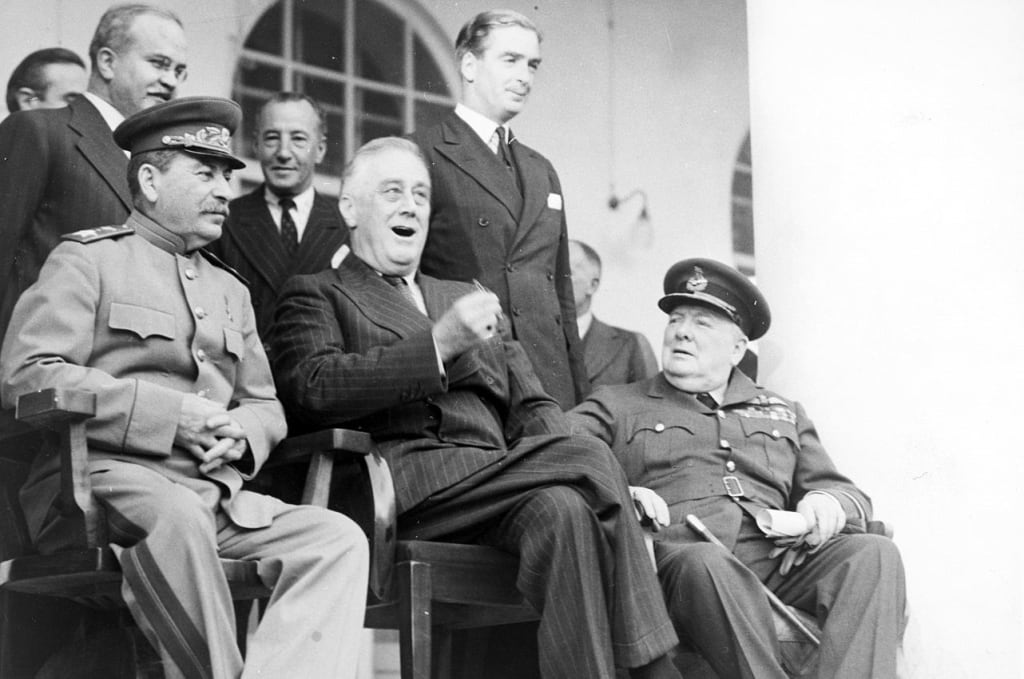
The Tehran Conference, held from November 28 to December 1, 1943, stands as a pivotal moment in World War II, where the leaders of the Allied powers—Winston Churchill of Great Britain, Franklin D. Roosevelt of the United States, and Joseph Stalin of the Soviet Union—convened to strategize the course of the war and outline their plans for the post-war world.
At the time of the Tehran Conference, the tide of the war had begun to turn in favor of the Allies, yet significant challenges remained, particularly in coordinating their efforts to defeat Nazi Germany and its allies. The meeting in Tehran provided a crucial opportunity for the leaders to align their military strategies and solidify their cooperation.
One of the primary objectives of the Tehran Conference was to discuss the opening of a second front in Western Europe, which had been a point of contention among the Allies for some time. Stalin, in particular, pressed Churchill and Roosevelt to commit to launching an invasion of German-occupied France to relieve pressure on the Eastern Front, where the Soviet Union was bearing the brunt of the fighting against the German army. This discussion laid the groundwork for the subsequent Allied invasion of Normandy, known as D-Day, which took place on June 6, 1944, and significantly weakened German forces by forcing them to fight on multiple fronts.
Additionally, the Tehran Conference facilitated coordination on military operations in other theaters of the war, including the Mediterranean and Pacific regions. The leaders discussed strategies for advancing through Italy and the Balkans to open up new fronts against the Axis powers and disrupt their supply lines. Moreover, they addressed the ongoing conflict in the Pacific, where Allied forces were engaged in fierce battles against the Japanese Empire. By coordinating their efforts across different theaters of war, the Allies aimed to maximize their collective strength and hasten the defeat of their common enemies.
Beyond military strategy, the Tehran Conference also served as a forum for discussing post-war plans and laying the groundwork for the establishment of a new international order. The leaders engaged in discussions about the principles that would guide the reconstruction of Europe and the world after the war. They reaffirmed their commitment to the principles of the Atlantic Charter, which emphasized self-determination, disarmament, and the establishment of a system of collective security to prevent future conflicts.
Moreover, the Tehran Conference provided an opportunity for the Allied leaders to build personal relationships and cultivate trust among themselves. Despite their ideological differences and competing interests, Churchill, Roosevelt, and Stalin recognized the importance of maintaining unity and cooperation to achieve their common goal of defeating the Axis powers. The camaraderie and rapport developed at Tehran would prove instrumental in the subsequent conferences held between the Allied leaders, such as the Yalta Conference in 1945.
However, it is essential to acknowledge the controversies and criticisms surrounding the Tehran Conference, particularly regarding the concessions made to Stalin and the Soviet Union. Some historians argue that Roosevelt and Churchill were overly accommodating to Stalin's demands, particularly regarding post-war territorial arrangements in Eastern Europe. The division of spheres of influence agreed upon at Tehran laid the groundwork for the subsequent Soviet domination of Eastern Europe and the onset of the Cold War.
In conclusion, the Tehran Conference of 1943 represented a crucial moment in World War II, where the Allied leaders came together to coordinate their military efforts and plan for the post-war world. By discussing military strategy, post-war reconstruction, and fostering personal relationships, Churchill, Roosevelt, and Stalin laid the groundwork for the eventual Allied victory and shaped the course of the twentieth century. However, the conference was not without its controversies, and its legacy continues to be debated by historians to this day.
About the Creator
nuwan
My goal is to share what i know with you





Comments
There are no comments for this story
Be the first to respond and start the conversation.